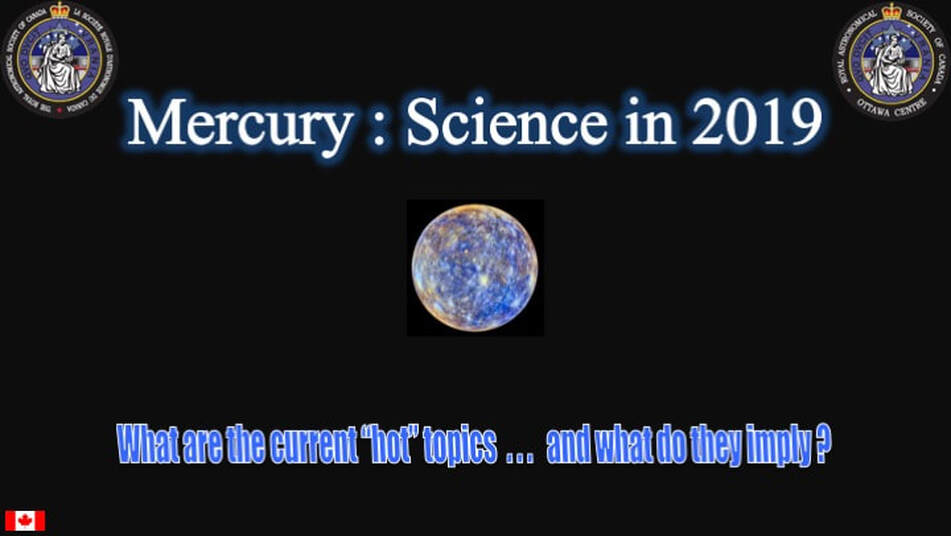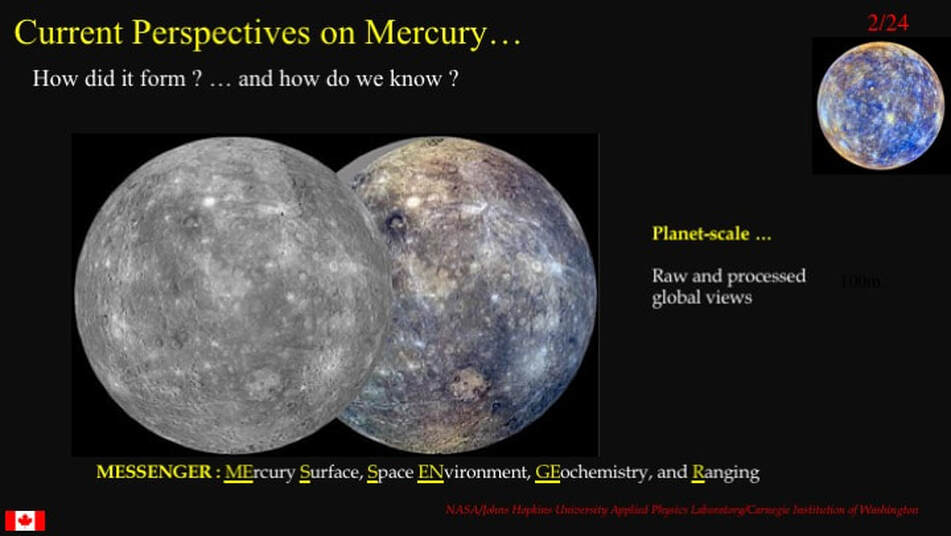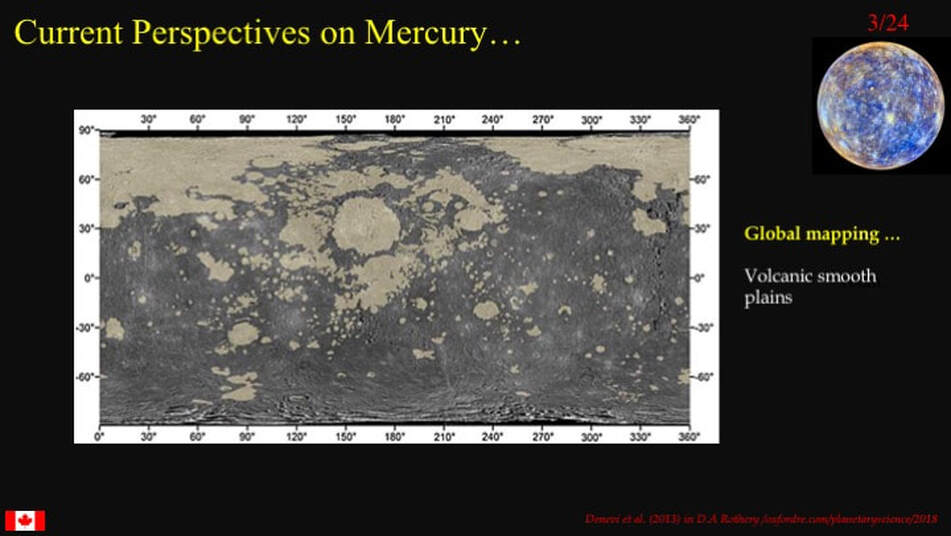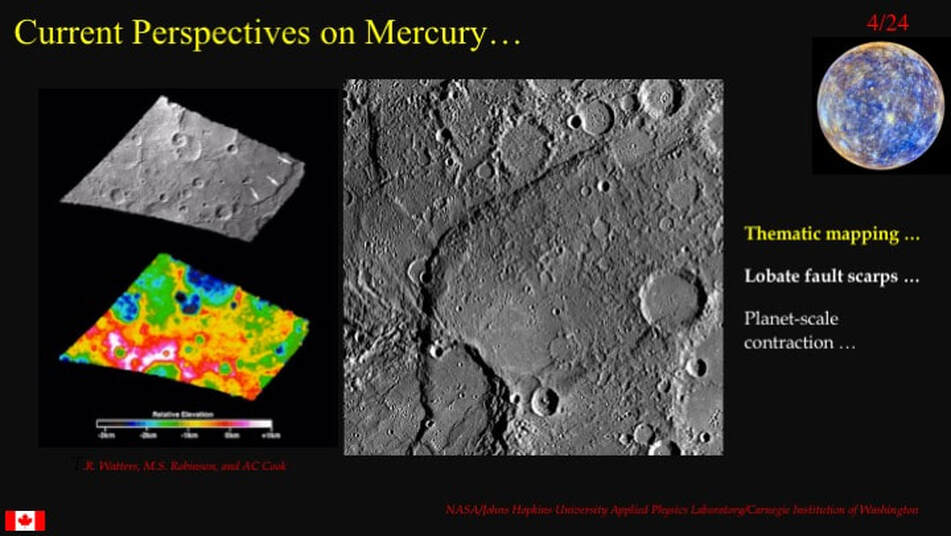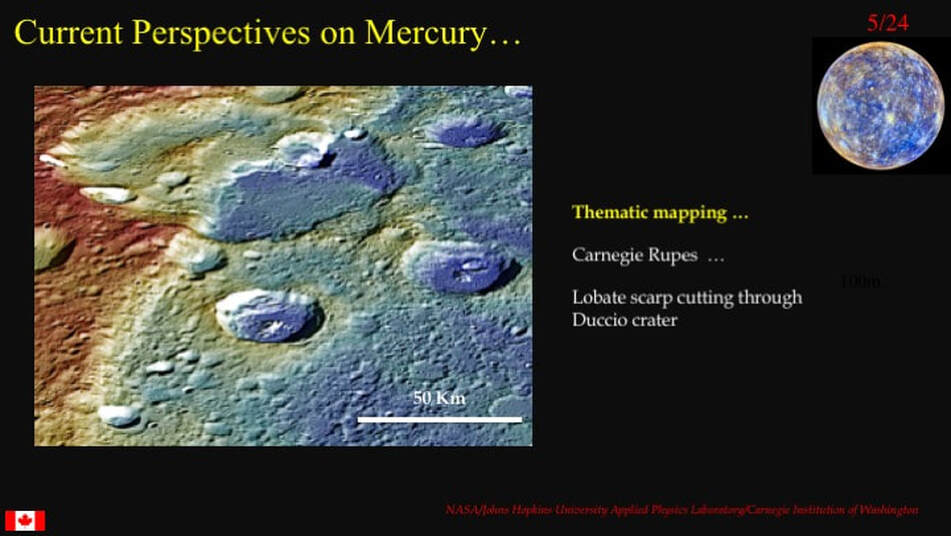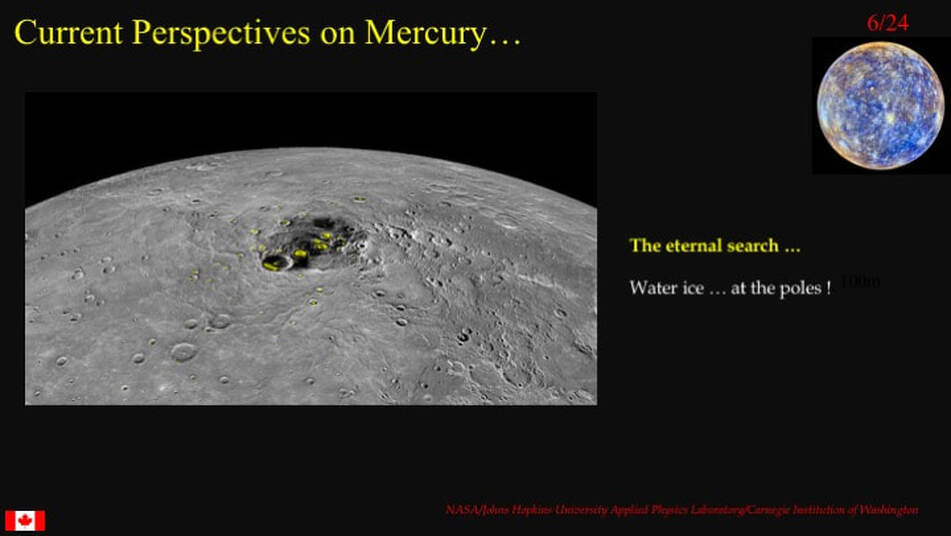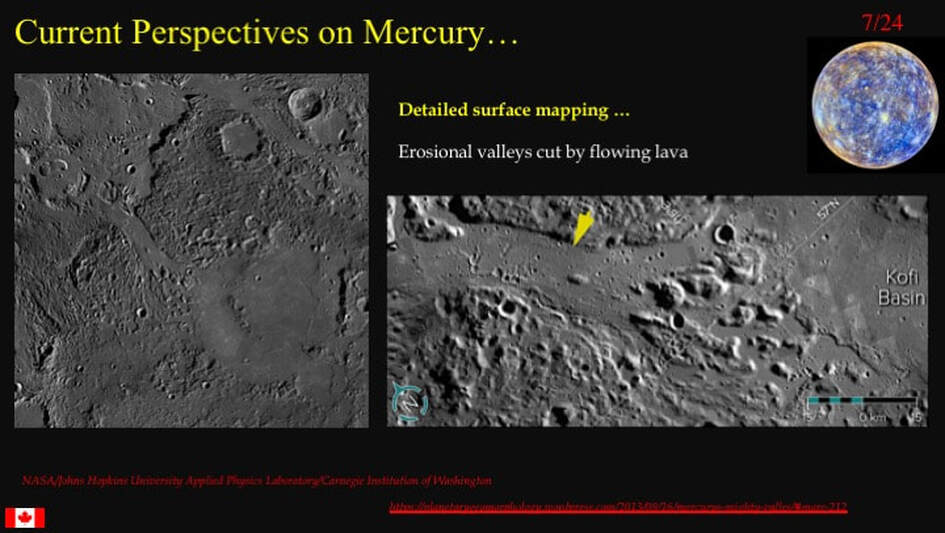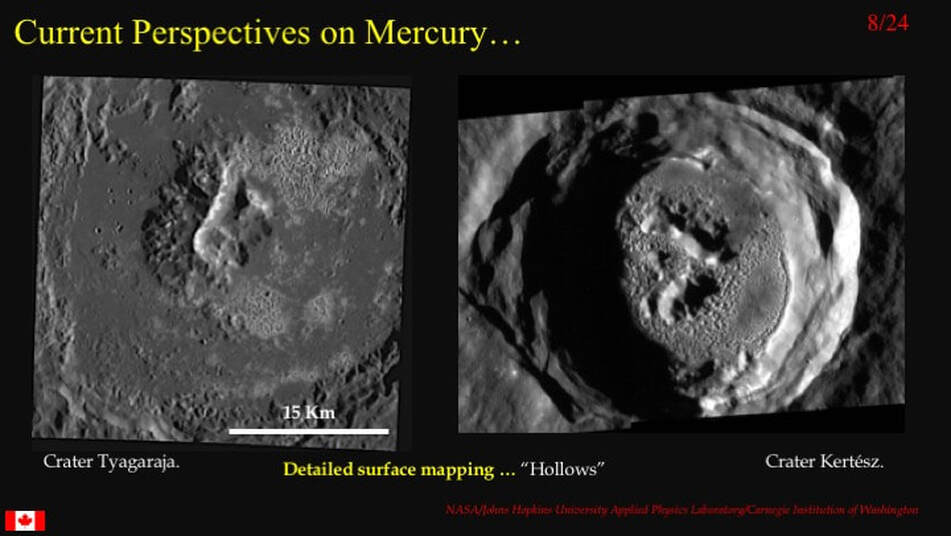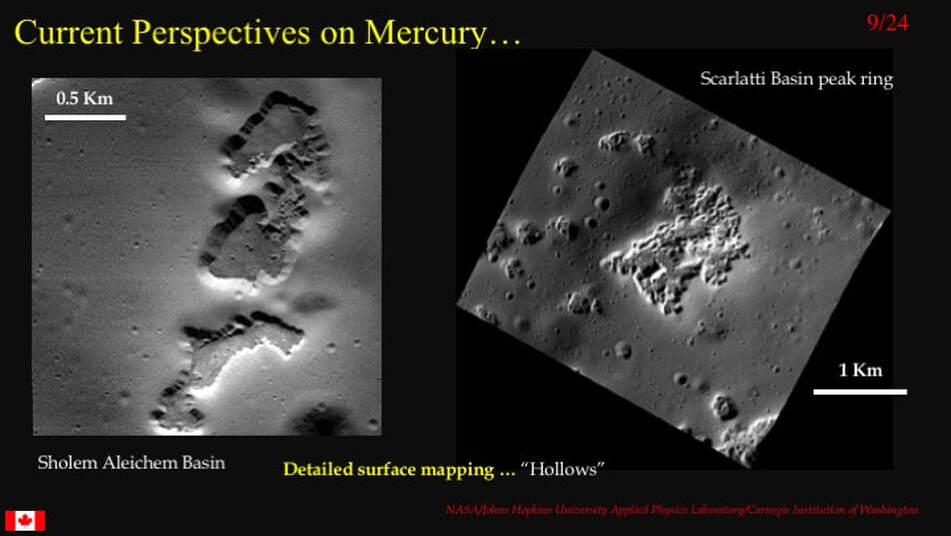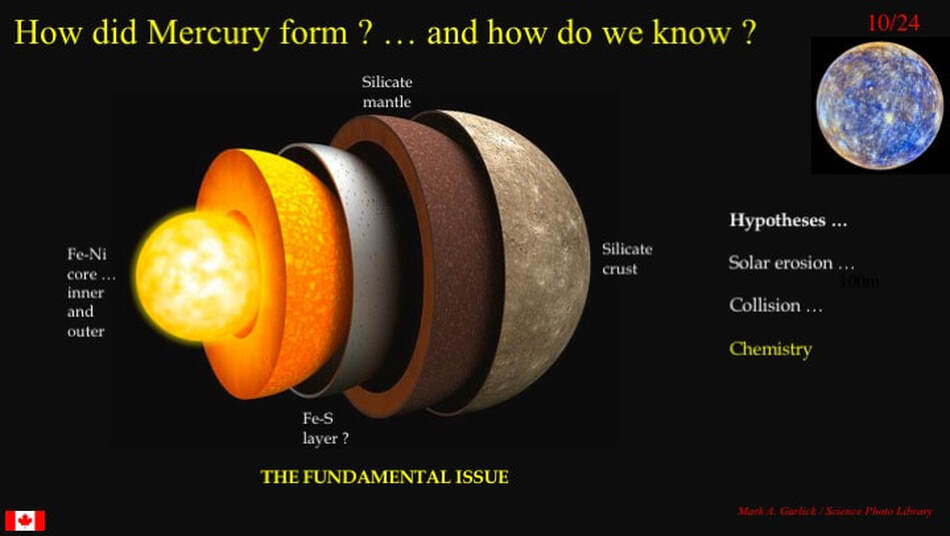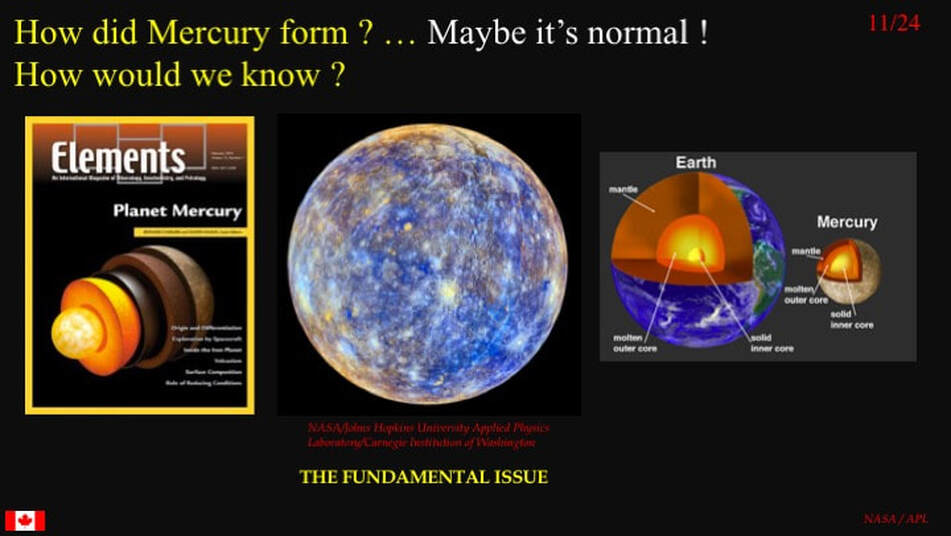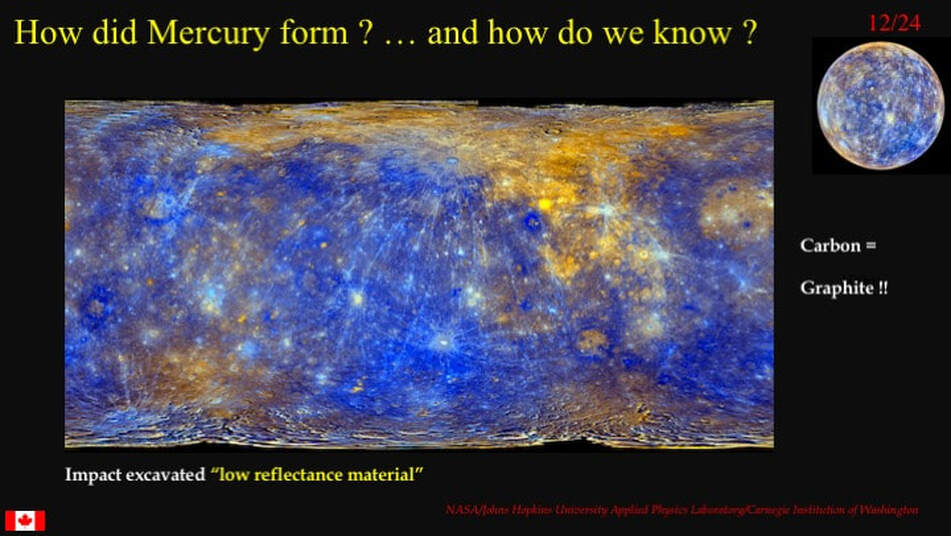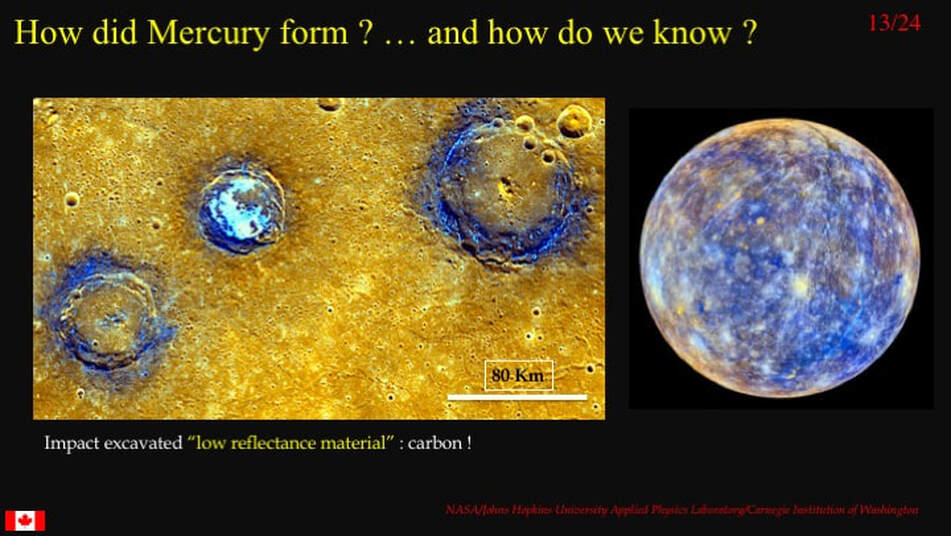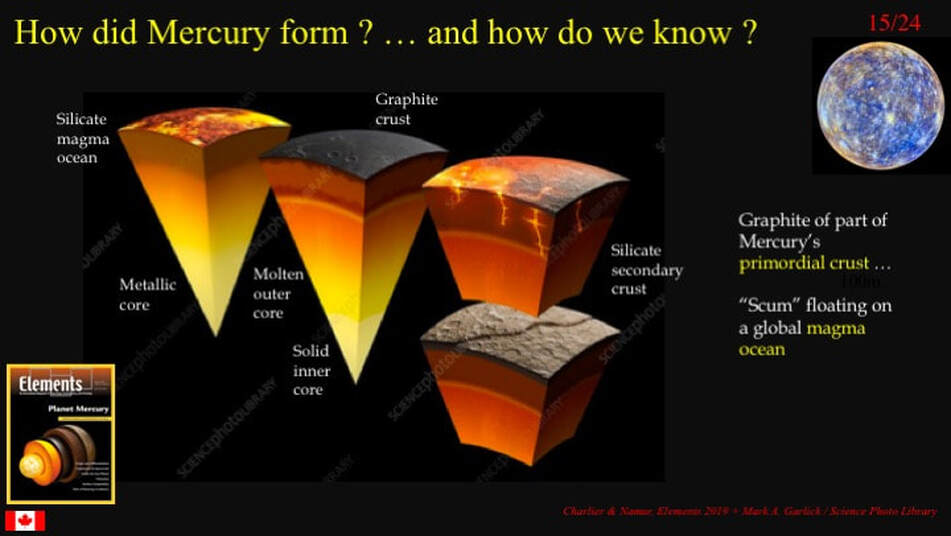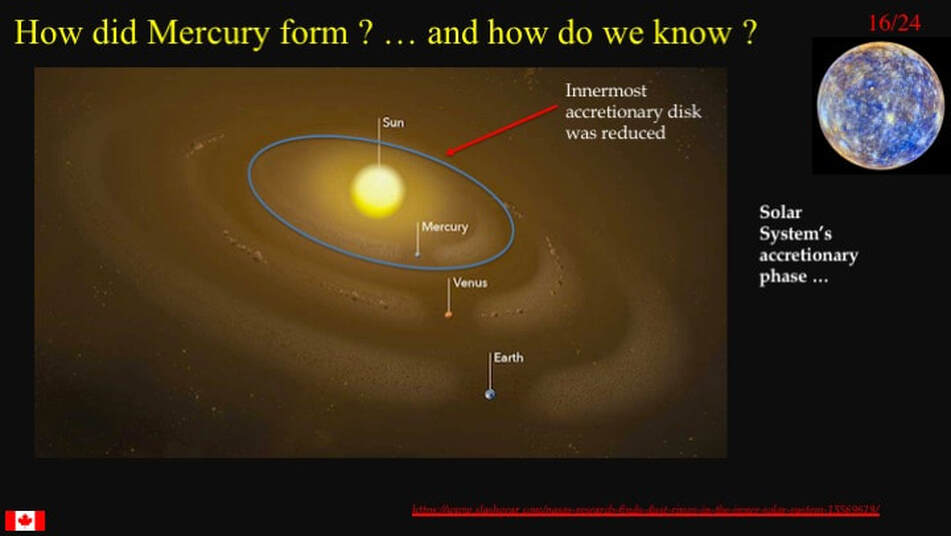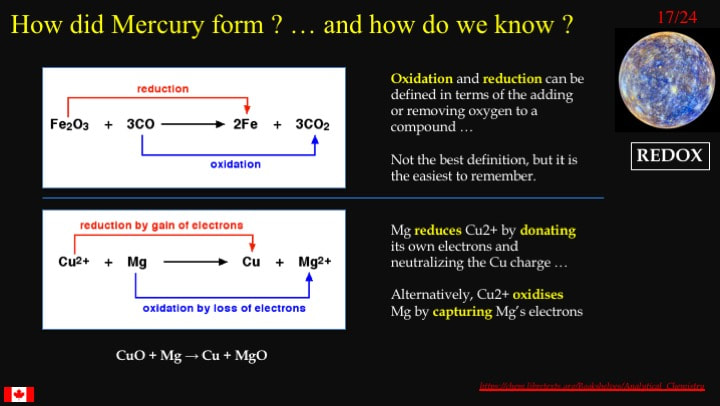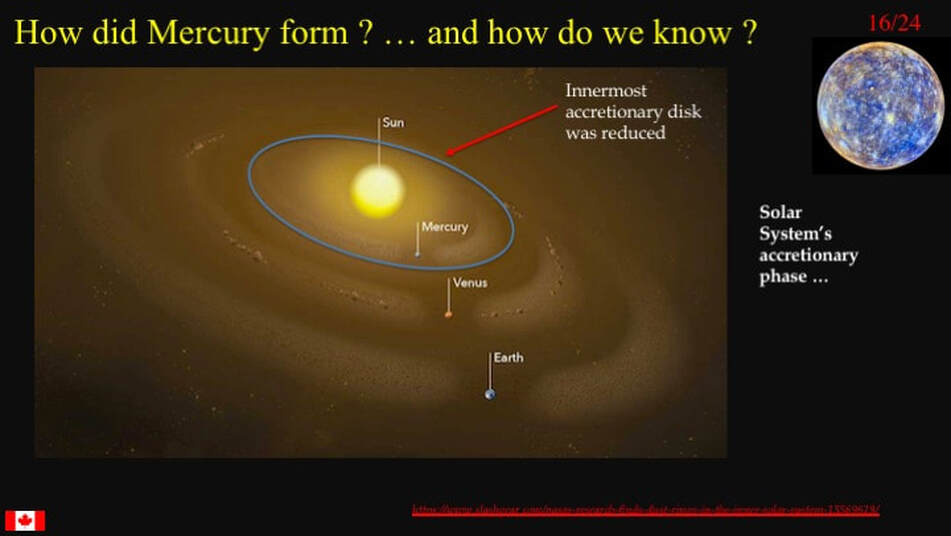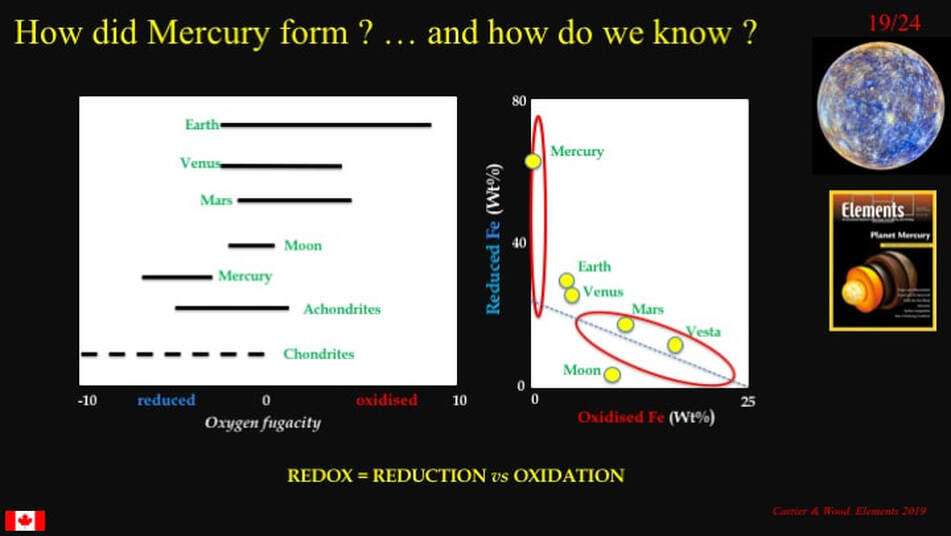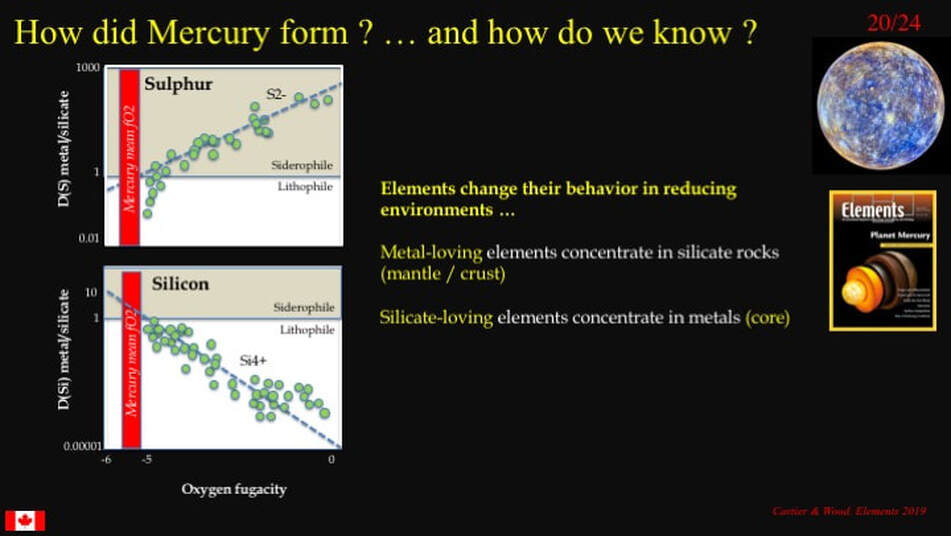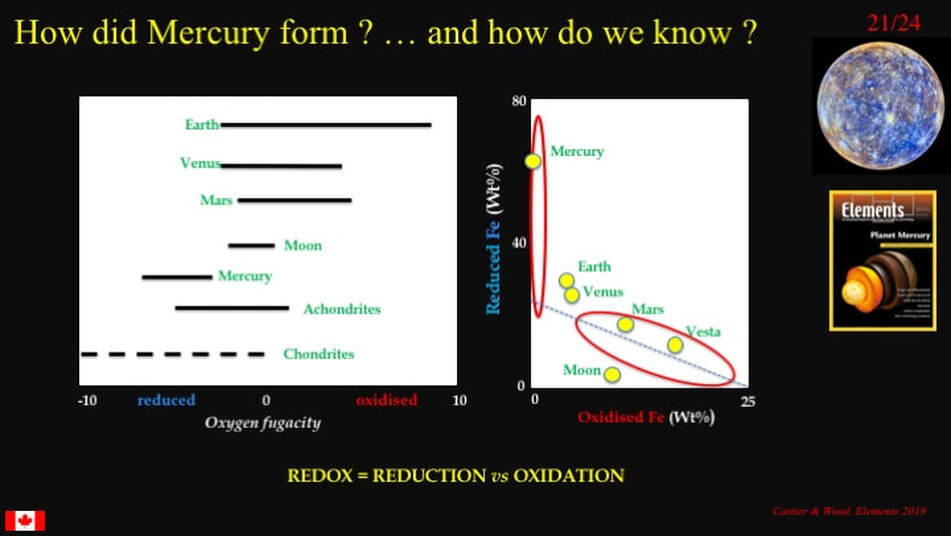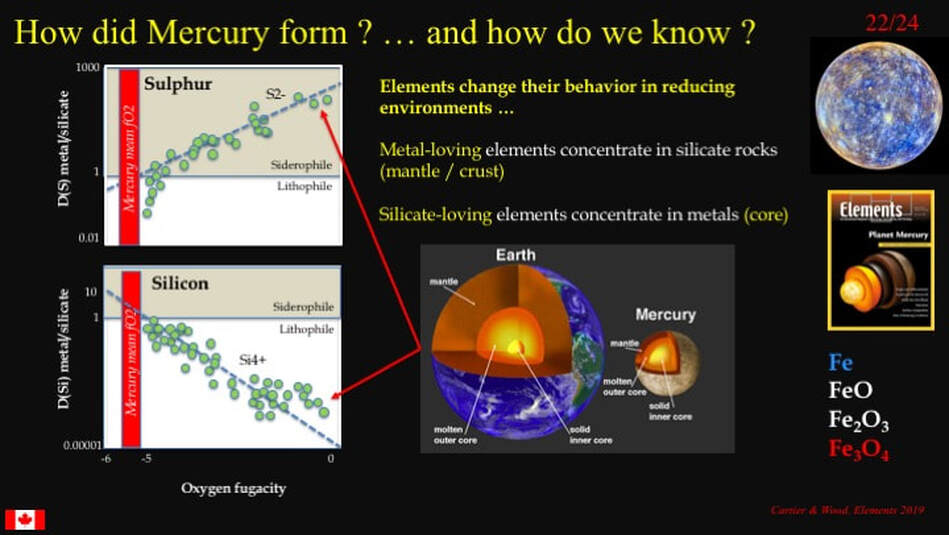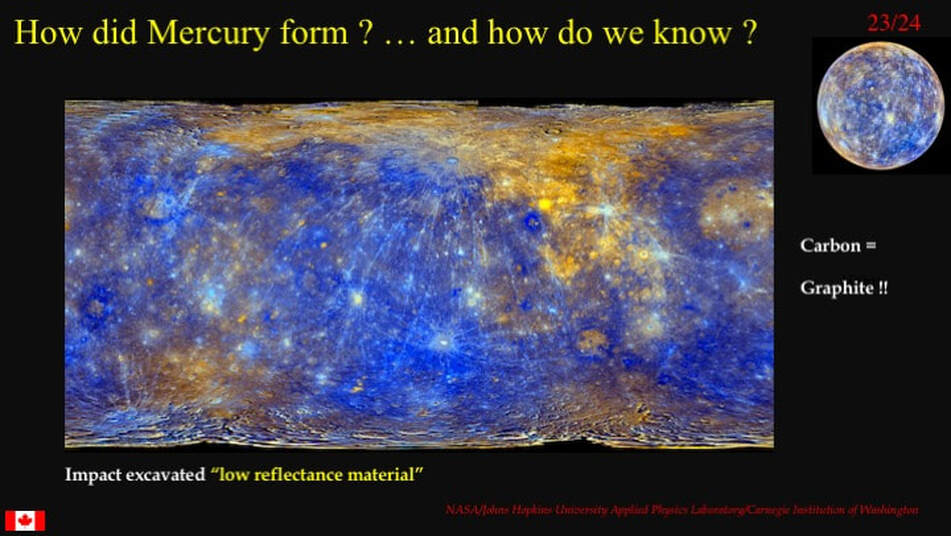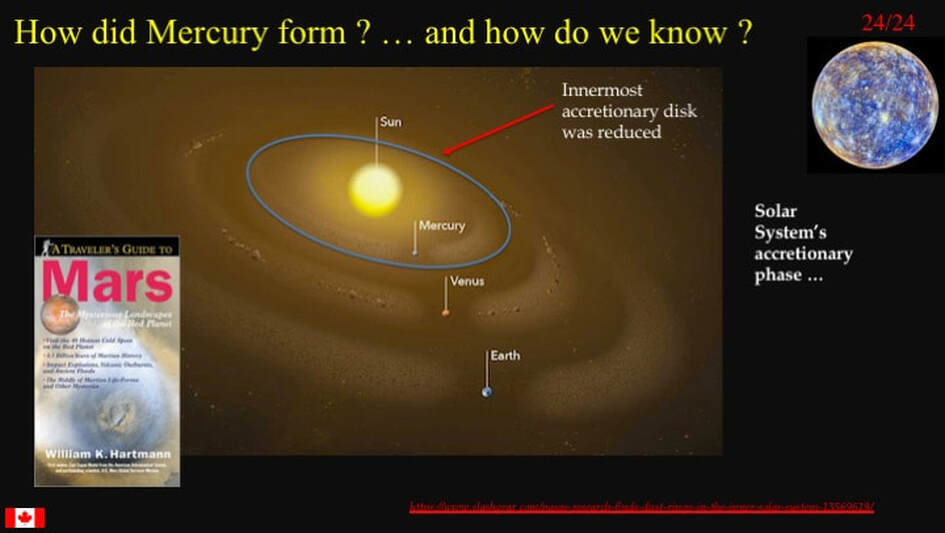|
MERCURY SCIENCE in 2019
|
In July of this year the RASC Ottawa chapter celebrated the 50th anniversary of the 1st Moon Landing. My contribution to that meeting was to look beyond the hype and the politics and discuss where Lunar Science stands in 2019. It then occurred to me that perhaps this was a good time to review where planetary science stands today with respect to our Solar System in general, a significant undertaking that would require a series of presentations to do it justice. So, I want to start with a look at Mercury. As with the Moon, I’m going to look at what’s hot scientifically speaking : what are the key questions that planetary scientists are asking themselves about the innermost planet in our System, and what answers are they finding. As you’ll see as the presentation unfolds, the key question regarding Mercury is not difficult to identify
After several fly-bys, beginning in 2008, the MESSENGER probe slipped into orbit around Mercury in 2011 and reported back until 2015. Data from MESSENGER have fundamentally upgraded our understanding of Mercury as both a planet and as a component of the history of our Solar System. To be blunt - if we don’t understand Mercury, then we don’t understand how Solar Systems work in general, either our own - or others around other stars
MESSENGER imaged Mercury’s surface at the planet scale, imaging much of the surface we had never seen before. It mapped the entire surface of the planet, providing us with global maps of the distribution of rock units – such as this map of the smooth plains of volcanic origin that dominate the northern hemisphere and polar region (white) – as distinct from other lavas (grey). One of the truly big surprises was how little iron (Fe) there is in the lavas that cover the entire surface of Mercury. On the other Rocky Planets, Fe and magnesium (Mg) go hand in hand, but not on Mercury. It turns out that this lack of Fe in the planet’s crust is going to be fundamental to understanding the planet, so bear it in mind. I’ll be coming back to this …
MESSENGER clarified thematic aspects that we had already seen in the partial coverage provided by the earlier Mariner 10 probe that performed a series of fly-bys (1974-5), but never orbited Mercury. This slide shows details of a lobate fault scarp that formed early in Mercury’s history as slabs of crust rode over each other when the once hot planet cooled and contracted
Here is another example of the same thing where a coloured digital elevation model (red for high ground, blue for low ground) is draped over a photo of a lobate scarp cutting across an older impact crater. It gives a better impression of the topography in 3D.
Even Mercury, closest rock to the Sun, provided evidence for the presence of water in permanently shadowed parts of impact craters around the planetary poles. NASA simply can’t resist highlighting water !!
More detailed mapping from orbit has also revealed large erosional valleys (15-20 km across) that look very much like the Outwash Channels on Mars that I talked to you about in 2014 (https://www.simonhanmer52.ca/voyage-to-mars.html) with streamlined hills as evidence for erosion. Except that on Mercury the agent of erosion was very runny Mg-rich (Fe-poor) lava rather than water !!
Credit (lower right) reads : https://planetarygeomorphology.wordpress.com/2013/09/16/mercurys-mighty-valles/
Credit (lower right) reads : https://planetarygeomorphology.wordpress.com/2013/09/16/mercurys-mighty-valles/
Even more detailed mapping has revealed strange features – apparently unique to Mercury – that may even be forming today : “Hollows”. These are small, flat bottomed pits with no rims and they seem to be confined to the floors or rims of pre-existing impact craters
The pits are pretty small and have very steep sides. Chemical analysis by remote sensing from the MESSENGER orbiter suggests that these pits may result from the sublimation of volatiles localised just under the impact crater floors and the lack of impact damage to the pits suggests that they are very, very young, possibly even modern ! As we’ll see shortly, the presence of volatiles in Mercury’s planetary crust was as unexpected as the low Fe content. Both require explanation : so now bear both in mind ! I will explain them shortly.
Much as all this new observational data is fascinating, and there’s lots more I haven’t even mentioned (see my 2008 RASC presentation https://www.simonhanmer52.ca/messenger.html), they don’t address the primary problem facing planetary scientists with respect to Mercury : a problem so important - and until now so intractable - that most scientific publications dealing with Mercury don’t seem to want to address it directly, even when they have appropriate evidence to contribute to the debate. That fundamental issue is this : Mercury doesn’t look like any other Rocky planet in the Solar System. Its planetary Fe-Ni core is way too big to be explained by the standard model of planetary accretion, heating, melting and differentiation, such that Mercury is sometimes called the Iron Planet. So the fundamental issue for planetary scientists is : how did Mercury form? For us as amateur astronomers, the question is : how do we (they) know ? What is running through the minds of planetary scientists as they tackle this issue ? There have been many attempt to explain Mercury’s internal structure ever since Mariner 10 in the 1970s, but we can group them into three main themes :
- #1 : Erosion of the primordial crust and much of the planetary mantle by the solar wind during the very early history of the Solar System, thereby leaving a disproportionately large Fe-Ni core.
- #2 : Erosion of the primordial crust and planetary mantle by a giant collision, or hit-and-run, “near-miss” style of gravitational interaction with another planetary body – potentially Venus or the Earth according to some.
- #3 : None of the above : maybe Mercury just formed the way we find it. Maybe the innermost part of the Solar System was very different to the rest of the accretionary disk.
In order to understand what this third hypothesis says, we have to delve a little into some chemistry. Now I know that some folks think that chemistry is difficult to understand, but it’s not, if it’s explained appropriately. In addition, we don’t need to know much more than the chemistry of pencil lead (graphite) in order to understand what planetary scientists are thinking with respect to the origins of Mercury - and why it’s is so different from the other Rocky Planets.
The magazine Elements is published by the national Mineralogical Societies of a whole slate of countries, and in February 2019 they put out a special issue on Mercury, with an emphasis on its origins as determined from its chemistry based on data from the MESSENGER probe. I hope that you’ve already noticed the blue tint in the insets of Mercury on the slides in this talk, shown even better in the blow-up of the planet …
The magazine Elements is published by the national Mineralogical Societies of a whole slate of countries, and in February 2019 they put out a special issue on Mercury, with an emphasis on its origins as determined from its chemistry based on data from the MESSENGER probe. I hope that you’ve already noticed the blue tint in the insets of Mercury on the slides in this talk, shown even better in the blow-up of the planet …
… and even better in this wrap-around global map. The blue colour is due to NASA’s processing, but it accurately reflects the distribution of graphite at the planetary surface. Graphite is a naturally occurring mineral, and it’s made of pure carbon. As we’re about to see, carbon is the key to the chemistry of the formation of Mercury. Have a good look at this map : can you see the impact craters surrounded by well-defined rings of blue carbon ? It’s pretty obvious that the carbon is in the ejecta thrown out from the transient cavities that formed due to the impacts, which means that the carbon was located at shallow crustal depths all over the planet.
Here’s a more detailed image of craters with their associated blue carbon located within the impact crater ejecta rings. So, what’s carbon doing sitting in significant quantities in the shallow crust of Mercury ? No other Rocky Planet shows so much carbon in its crust : it’s unique to Mercury.
Planetary scientists interpret the graphite as the “scum” that floated on top of a primordial global magma ocean that formed from the heat of accretion +/- heat from short-lived radioactive isotopes such as Al26. But why “graphite scum”, and why is it unique to Mercury ? After all, a similar global magma ocean “scum” on the Moon gave us the plagioclase feldspar of the white lunar highlands ! It’s all to do with the role of carbon in the chemistry of that global magma ocean, and I’ll explain that in just a minute. Meanwhile – think about the significance of a primordial crust containing graphite “scum”. Even if impact events have to dig it up from a few km down, it is still a crustal component. It’s simple presence in the present crust can only mean one thing : the primordial crust and planetary mantle of Mercury were never removed from the planet. If this is true, then we are left with no choice : we have to assume that Mercury formed as we find it, with a disproportionately large Fe-Ni core : and that requires explanation.
If Mercury formed as we find it - and where we find it - then there had to be something special about the innermost part of the accretionary disk from which the Solar System formed … and this is where chemistry comes in.
The credit reads : https://www.slashgear.com/nasas-research-finds-dust-rings-in-the-inner-solar-system-13569619
The credit reads : https://www.slashgear.com/nasas-research-finds-dust-rings-in-the-inner-solar-system-13569619
It turns out that chemistry can explain a lot about Mercury - if the planet formed in a highly “reducing” environment. So now we need to know something about “reduction” and its opposite number : oxidation – commonly abbreviated as REDOX. Common sense tells us that oxidation is the addition of oxygen to something : think of the case of a rusty nail. So common sense must also tell us that reduction is the removal of oxygen from something. However, while this may make common sense, it’s a limited way of understanding what really happens – especially when we get to carbon !
In order for the oxygen to hitch or unhitch itself from other elements, something must happen at the level of electrical charges to facilitate this. Take a look at the second example here (CuO + Mg = Cu + MgO), which is also presented in terms of electrical charge : in this case just positive and neutral). The Cu2+ that’s hitched to the oxygen has 2 protons that are NOT balanced by negative electrons : hence the double positive charge. To make it neutral (Cu) we need to unhitch the oxygen, and to do that we need to find two spare negative electrons in order to balance the protons in the atomic nucleus. The opposite applies to the Mg, which is neutral : to hitch it to the oxygen we just unhitched from the Cu we need to remove two electrons to make the Mg positive, or the oxygen simply won’t play ball. So the reaction runs from left to right because the Mg donates 2 electrons to the Cu, which we express as Mg reduces the Cu (or we could say that the Cu oxidises the Mg : it comes to the same thing). The key thing to retain here is that something (A) is reduced when something else (B) donates electrons to A.
The credit reads : https://chem.libretexts.org/Bookshelves/Analytical_Chemistry
In order for the oxygen to hitch or unhitch itself from other elements, something must happen at the level of electrical charges to facilitate this. Take a look at the second example here (CuO + Mg = Cu + MgO), which is also presented in terms of electrical charge : in this case just positive and neutral). The Cu2+ that’s hitched to the oxygen has 2 protons that are NOT balanced by negative electrons : hence the double positive charge. To make it neutral (Cu) we need to unhitch the oxygen, and to do that we need to find two spare negative electrons in order to balance the protons in the atomic nucleus. The opposite applies to the Mg, which is neutral : to hitch it to the oxygen we just unhitched from the Cu we need to remove two electrons to make the Mg positive, or the oxygen simply won’t play ball. So the reaction runs from left to right because the Mg donates 2 electrons to the Cu, which we express as Mg reduces the Cu (or we could say that the Cu oxidises the Mg : it comes to the same thing). The key thing to retain here is that something (A) is reduced when something else (B) donates electrons to A.
The credit reads : https://chem.libretexts.org/Bookshelves/Analytical_Chemistry
So, now that we know that what “reduction” means, where does carbon fit into all this ? For reasons we’re not going to get into here, it turns out that carbon is a great electron donor. It just loves giving up electrons to other elements, and thereby reducing them ! Having carbon (graphite) around is a great way to produce a reducing environment. So, what does this have to do with Mercury and how it formed as a planet ? What if the innermost part of the accretionary disk of our early Solar System had a significant carbon content ? So far, I haven’t read an explanation of why that might be the case, but we do have observations that point in that direction !
The credit reads : https://www.slashgear.com/nasas-research-finds-dust-rings-in-the-inner-solar-system-13569619
The credit reads : https://www.slashgear.com/nasas-research-finds-dust-rings-in-the-inner-solar-system-13569619
I’m going to show you two slides of diagrams that I have redrawn from one of the papers in the Mercury issue of Elements magazine. Here’s the first. On the left is a diagram showing the degree of reduction vs oxidation (REDOX state or oxygen fugacity) measured for the Rocky Planets and meteorites. As planets go, Mercury stands out as sitting entirely within the reduced field (negative values). On the right is a diagram showing oxidised Fe vs reduced Fe, and again, Mercury stands out as being made of way more strongly reduced Fe than the other planets. The red ellipses indicate the redox states for different groups of meteorites, and Mercury clearly stands apart from all of the rocky components of the Solar System, including the meteorites.
Now we are equipped to look at what planetary scientists think they have found that allows them to explain the formation of Mercury. It turns out that many elements modify their chemical behaviour depending on whether they find themselves in an oxidising or a reducing environment. This change in behaviour is dramatic, as these diagrams on the left show. Note that the redox environment illustrated here goes from “average” on the right (0 : think Goldilocks - not too oxidising, and not too reducing) to highly reducing on the left (negative values). The vertical red bar represents the values measured for Mercury. The top diagram is for sulphur (which normally prefers to form sulphide minerals in a planetary core), while the lower diagram is for silicon (which normally prefers to form silicate minerals in a planetary crust or mantle).
We’ve just seen that in most of the inner Solar System, the chemical environment where the other Rocky Planets formed was pretty much average : Goldilocks !
In such an environment, your standard accreting Rocky Planet – such as the Earth, Venus or Mars - heats up and differentiates such that elements that tend to prefer to bond with metals (sulphur - Fe-Ni : siderophile) end up in the core, while other elements that tend to prefer to bond with rock-forming silicate minerals (Silicon-Al-Ca-K-Na-Oxygen : lithophile) end up in the planetary mantle or the crust - and that’s where we get our standard model of a differentiated Rocky Planet from. However, when an accreting Rocky Planet differentiates in a highly reduced environment, something remarkable happens. Elements that normally prefer to bond with the planetary core end-up preferring to bond with silicate minerals, and most importantly those that normally bond with the planetary crust and mantle prefer to segregate into the core. A diagram for the behaviour of Fe would look somewhat like the diagram for silicon, but more complicated because Fe comes in all kinds of states of oxidation. The oxidised states tend to end up in silicate rocks, while the reduced state prefers to go into the planetary core. However, in a highly reducing environment, much more of the planetary iron is reduced and so much more of it goes into the planetary core, and that core becomes abnormally large ! Remember what I told you at the beginning of the presentation : Mercury’s crust is abnormally poor in Fe compared with the other Rocky planets, and is unexpectedly rich in volatile elements. As we’ve just seen, both of these observations support the hypothesis of Mercury forming in a highly reducing environment.
So, what’s the explanation for all that carbon in Mercury’s crust? It so happens that an Fe-poor (Mg-rich) global magma ocean has too low a density to allow silicate minerals to float and form a surface scum (not even light-weight plagioclase, the dominant lunar surface mineral). The only element that could have floated to form a surface scum would have been carbon, which we find as graphite.
Now - the next question is : why was the innermost part of the Solar System a highly reducing environment, potentially rich in carbon ? But that’s a question for another day. Meanwhile, what’s my take-home message here ? Well, it’s somewhat philosophical. The identification of carbon as a relic of Mercury’s primordial crust is not new : we’ve been hearing this for quite a while. Yet, even recent papers continue to entertain the hypotheses that require removal of the planetary crust and outer mantle to explain the origin of Mercury. Even the papers in the Mercury edition of Elements magazine do not explicitly state that the crustal-removal hypotheses must be wrong, even though they are delivering explicit support for the existence of primordial crust. Why is this ? It’s certainly not limited to Mercury. The highly respected senior planetary scientist William Hartmann has just published a comprehensive review of the history of the concept of the Late Heavy Bombardment and the purported Lunar Cataclysm : History of the Terminal Cataclysm Paradigm: Epistemology of a Planetary Bombardment That Never (?) Happened : https://www.mdpi.com/2076-3263/9/7/285. See also my 2016 RASC presentation : https://www.simonhanmer52.ca/lunar-cataclysm.html, as well as my 2004 review of Hartmann’s book on Mars “ https://www.simonhanmer52.ca/mars--travelers-guide.html In his paper Hartmann is strongly critical of how science evolves in the real world : “As science gels into paradigms, human culture, by definition, begins to influence the paradigm along with the science … as a paradigm becomes influential, new research begins to become influential not only for the quality of the work, but also because it fits within the paradigm.” In short, he is saying that scientists tend hear what they want to hear, and tend to ignore what doesn’t fit with their favoured or current model. It would appear that this is now endemic in planetary science : for example, see my 2016 RASC presentation on Pluto : https://www.simonhanmer52.ca/pluto-update-2016.html.
The credit reads : https://www.slashgear.com/nasas-research-finds-dust-rings-in-the-inner-solar-system-13569619
The credit reads : https://www.slashgear.com/nasas-research-finds-dust-rings-in-the-inner-solar-system-13569619
Proudly powered by Weebly
